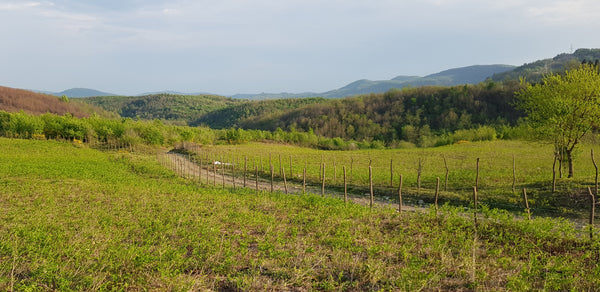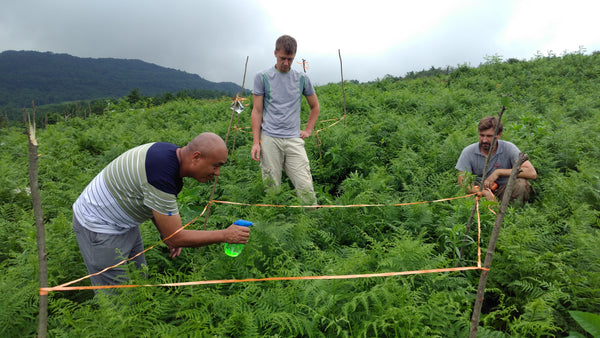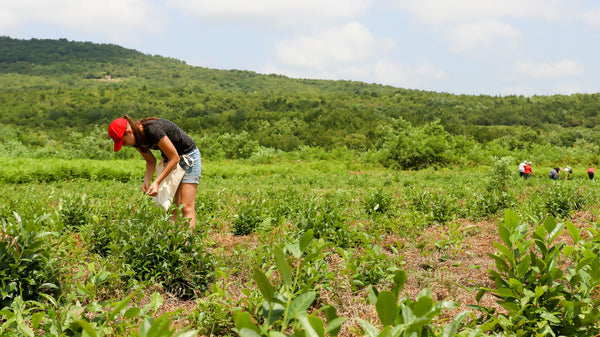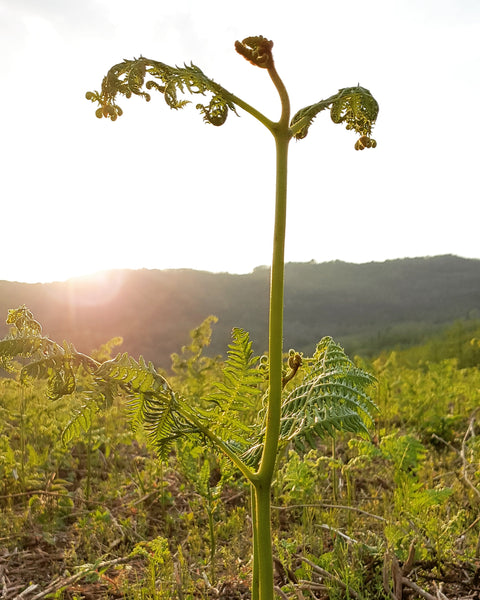From an abandoned jungle to a working tea plantation. Part two.
Kristiina Mehik1. The first shoots come out...
So, we cleaned the first plantation, Renegade Estate, in the winter of 2017-2018. After finishing the cleaning works, there were 4 long months of waiting until we saw that tea was actually starting to come back on most parts of the plantation. During this time we heard a lot of opinions that we should put concentrated, chemical fertilizers and without this, it will not start to grow or will grow very poorly. At some point, I think we even started to question ourselves, thinking that maybe it is true, maybe we can’t do it without fertilizers. But we were determined to do it organically, so we waited a little more.
2. A lot of fern...
Of course, fern didn’t take any time off and started to grow in two weeks after the cleaning. So, the first question we had was how to get rid of it. One thing was clear, we’re not putting any herbicides.

All the green you see here are weeds, not tea.
So, it was going to be all manual work. Here’s a list of things we tried:
- Minitractors - we realized quite quickly that this is not possible since even though the rows are very visible from a satellite view, they are not visible at all when the field is empty and you are standing in the middle of it. Technically, you could've found the rows with a map, but as we saw a lot of tea roots coming up during the process, then we stopped it.
- Trimmers - Quite an efficient way, also doesn’t disturb the soil that much, so it’s maybe even better than a minitractor. With the exception that our workers also trimmed down quite a lot of young shoots of tea bushes. It felt like they hadn’t really understood that we weren’t just cleaning the fields, but we wanted to grow tea bushes also :) Well, this project needed to end as well.
- A hoe (tokhi in Georgian and kõblas in Estonian) - the method we have been using for 2 years now, very time consuming and labor heavy, but gets the work done and the tea bushes are not harmed.
- Handwork - the most difficult areas have been purely handwork, because when the weeds are high and tea is small, then it needs extra attention and care so the young shoots wouldn't be harmed.
- Acidic acid - we tried to drive away fern by spraying some acidic acid on it. It worked, kind of, but it also worked on tea. So, we ended that test as well.

Trying the acidic acid solution on test areas.
Now that the bushes are already bigger and can be seen inside the fern, we will be testing the trimmers again. Fingers crossed :)
3. The very first plucking!
The very first leaves we plucked from Renegade Estate at the end of July 2018. The amount was very very small, but boy, did that feel good. It was hard work, the bushes were small and we are tall :) Also, we needed to see that we harvest the leaves on the right level, so we wouldn’t pluck too much on one shrub or those bushes that were still too small to be plucked. The first harvest from Renegade Estate brought us 5 (!!!) kg of fresh leaves - that gave us just approximately 1 kg of ready-made tea. But it was our very first tea, so we were more than happy with that! All in all, we got 143 kg of green leaves from Renegade Estate in the first season (August-September 2018)

The bushes were small and backs were aching.
4. Cleaning, cleaning, cleaning
When we decided to become tea farmers, we had quite a few pictures in our heads what it would be like. Spending countless hours and tons of money to get out fern from our fields, was not one of them.
The situation with fern was really something that we weren’t prepared for. A good example is how we left Georgia at the beginning of March when the fields were brown and came back in two weeks only to find a complete jungle of fern in front of us. The plants were up to our knees! After we shook off the shock, we prepared for war. And war it was for the whole first year. Whenever we were about to finish cleaning the plantation, the beginning started to overgrow again. Somehow, we made it until September when nature started to slow down and we could catch a breath with the cleaning works.
 Did you know that fern grows 11 cm in a day! Eleven! Per Day!
Did you know that fern grows 11 cm in a day! Eleven! Per Day!
5. The first spring
We got back on the fields in January already. This time we knew better and started to fight with fern long before it even came out of the ground. We cleaned the whole plantation again to get the fern roots out as much as possible.
Since the fight with fern was heavy, then we “abandoned” a few parts of the plantation in 2018. We just couldn’t keep everything under control and those parts where tea was growing very slowly or wasn’t growing at all, we decided to leave behind for the time being. In spring 2019, we cleaned those areas again and to our surprise, those plots weren’t so bad actually. Tea had survived and even grown to an adequate hight and strength under the fern.
6. Ugh, cleaning
Obviously, the preventive works didn’t eliminate the problem with fern completely. However, in the second year, we did see some signs that it’s getting weaker and tea bushes are getting stronger. On some plots, it was even replaced with some tall grassy plants and some areas looked like a meadow for a picnic. While we do understand that the less there are weeds the more nutrients the tea bushes get and the healthier they are, then we just didn’t have the resources to keep the fields completely clean. So, if there was anything else than fern growing, we were quite happy. Also, biodiversity is actually a good thing in the plantation. As we are following organic farming principles, we will never have a completely clean and tidy plantation.
We were a little more confident now as we saw some progress, but there were still moments when we were overwhelmed with it. Like when you went home for a week and came back to see that a plot that was just cleaned was a jungle again. Or when we calculated how many days there are until we can pluck a certain plot and tried to estimate if we will get there to pluck or fern would be too high…

If anybody knows for what we could use fern, so it would be actually useful, then we are all ears!
7. We have tea leaves to pluck, but why so few?
In the second season, our plucking got more effective as well. The bushes were growing already quite well and with one round of plucking, we got an average of 350 kg from 10 hectares. This wasn't the volume we had estimated, but it was good progress from last year.
When we started with the rehabilitation works, some people told us that we can't get anything for the first 3 years, some said that already in the first year we will get 10-20% of the total potential harvest. Our reality has been that in the first year you get next to nothing and in the second year you get some 5-6% from the total potential harvest. That is if you grow organically.

Though, there were also some things we couldn't figure out. Firstly, the productivity of the best plot of 2018 was way lower compared to others in 2019. Some areas we could only harvest once, while a neighboring plot we managed to pluck 2-3 times during the same time. We tried to play with the water levels, to see if it helps somehow, it didn't. We tried to see if there is something missing from the soil and we even tried bio-fertilizers as a test on one of the low-productivity areas, also didn't help. So, we'll need to continue to solve this puzzle this year...
All in all, after two years, we do see progress in both slowing down the growth of fern and getting the tea bushes bigger. Since we are growing organically and not rushing the plants to grow fast, then they just need some more time to gather their strength and grow. We'll let nature do it's thing and help as much as we can on the side :)
Written by Kristiina
